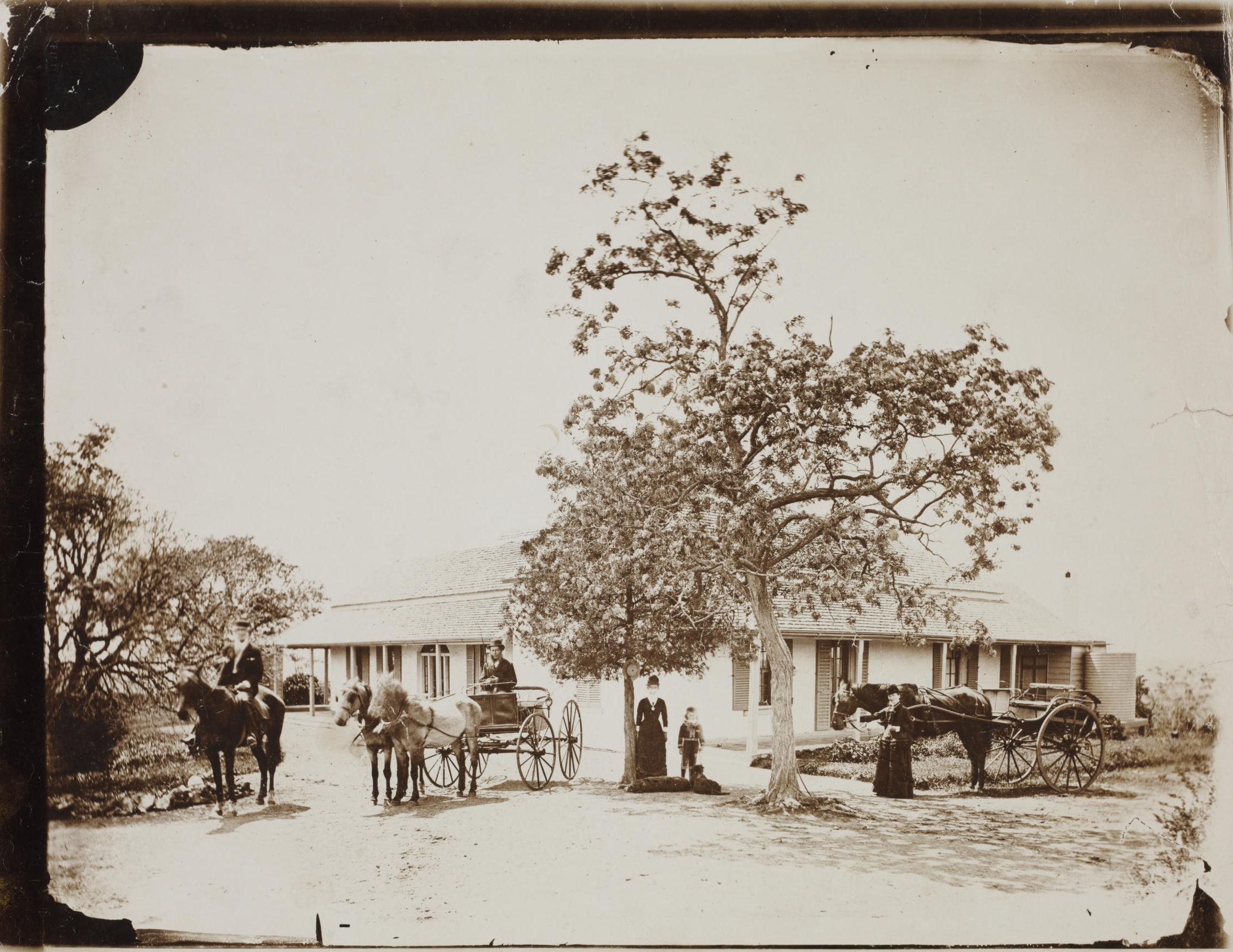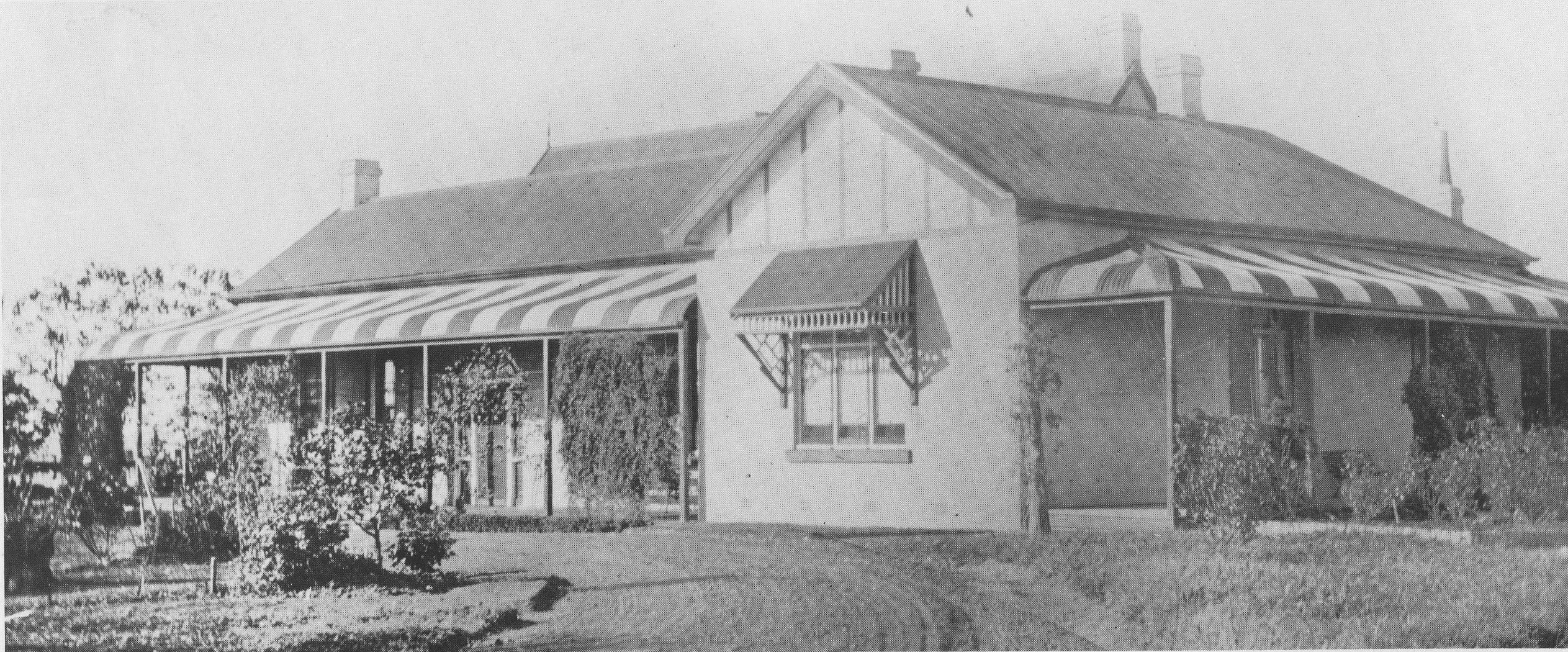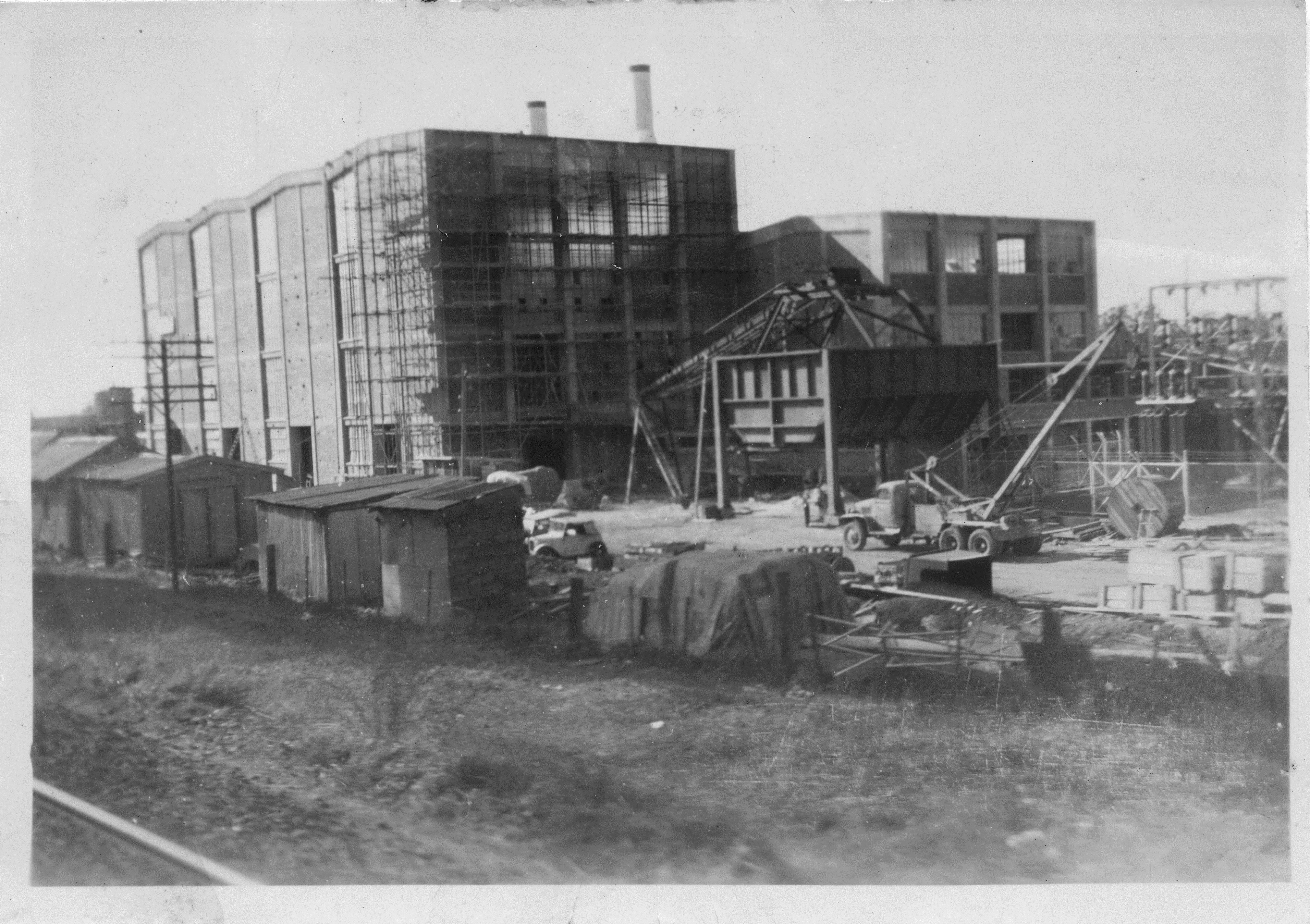Casula was officially gazetted on 7 April 1972 as part of the Parish of St Luke and Minto.
Scarred Trees
Thousands of surviving trees in NSW bear scars resulting from the removal of bark or wood by Aboriginal peoples in the past for the manufacture of canoes, shields and other artefacts. There are a number of scarred trees that have been recorded in Casula.
One, found in Lucas Heights in the 1990s, is on display at the Liverpool Regional Museum, kindly on loan from the Gandangara Local Aboriginal Land Council.
Colonial Land Grants
Casula is comprised of land grants originally made to Dr Charles Throsby, Richard Guise and Captain Eber Bunker (1761-1836).
Glenfield
Glenfield Farm still stands on Leacocks Lane and is the oldest continuously worked farm in Australia. It is one of the few surviving rural properties dating from an 1810 land grant. Dr Charles Throsby named the farm Glenfield after his birthplace in Leicester, England. Throsby was an eminent colonial officer and explorer.
In the twentieth century the farm was associated with James Leacock, an innovative dairy farmer, entrepreneur and idealist.
The oldest section of Glenfield Farm was built in 1817, with later additions between 1820 and 1840, and again in the 1890s and 1932. The homestead is one and a half stories with a cellar and is of an old Georgian architectural style.
Casula
Richard Guise, whose grant was next to Throsby’s, called his farm Casula. Guise was of French ancestry and it is thought that Casula may be an Anglicisation of “la case sur la” which may have meant “the hut on the,” although modern interpretation means “the box on the.” Guise received a 120 hectare grant in 1809, and his farm was well established when Governor Macquarie toured the area in 1810. Guise was the first person to be buried in Liverpool Pioneers’ Memorial Park.
Collingwood House
Collingwood House, 13 Birkdale Crescent, off Congressional Drive, is situated at the Collingwood Precinct which was officially named an Aboriginal Place and acknowledges the traditional owners of the land. This precinct was a significant meeting place for the Tharawal and Darug people and, with the Tucoreah-Georges River nearby, a source of valuable natural resources.
The original five-bay house forms the kitchen at the rear of the current house. Colonial Georgian elements and a gable section were added in 1860. The service block was built in 1865.

Collingwood House, eighteenth century
Occupants of Collingwood House
Captain Eber Bunker
Collingwood was part of 1,000 acres of land granted to Captain Eber Bunker in 1804 by Governor King and 1810 by Governor Macquarie. The northern part of Casula was originally included in Bunker’s grant which extended from the Tucoreah-Georges River to the present Webster Road, and from Mill and Hoxton Park Roads to Kurrajong Road. The house was built in about 1810. Collingwood was the family name of Bunker’s mother in law, Isabella. Bunker died at Collingwood in 1836.
Bunker had arrived in Port Jackson from Massachusetts, America in 1791 at age 29 in command of a convict transport ship, the William and Ann. He received a “most honourable mention” for the good condition of the convicts he had transported to the colony. Bunker had fitted out his ship for whaling, as he had intended to go whaling off the coast of Brazil after he had delivered the convicts to Sydney. However, many whales had been spotted off the coast of Australia, so he remained here to captain the first whaling expedition in Australian waters. Bunker is often referred to as the ‘father of Australian whaling.’ Eber Bunker was also one of the first to send cattle to the southern districts of NSW, becoming a founder of Australia’s cattle industry. The Bunker Islands in Queensland are named after him.
The Blacketts
In about 1830, couple George Blackett and Charlotte Bunker moved from Rooty Hill to Collingwood. George took up a position as a government contractor. The Blacketts had married in 1826, and they went on to have 11 children, four of whom married.
After Eber died in 1836, Charlotte inherited the farm. In 1837, George had 14 convicts assigned to him, of which only one was a woman, Mary Murrell. We can only imagine the isolation experienced by Charlotte and Mary. George constructed a steam flour mill in the northeast corner of the Collingwood Estate towards Liverpool town down by the Tucoreah-Georges River, which began operation in 1841. By 1842, his business ventures had sent him into insolvency. Charlotte took out mortgages to try and prevent him from being jailed, but in 1845 the couple were forced to sell Collingwood Estate to repay their debts.
The Balckett’s insolvency papers give a vivid picture of life at Collingwood. From the list of valuables, furnishing, household goods, stock, tools and equipment it is clear that Collingwood remained a ‘gentleman’s residence’ modelled after the English fashion of the time during their period of ownership. At this time, the house had six or seven rooms, thought to be a drawing room, dining room, hall and three bedrooms. The insolvency records show that the Blacketts earned money from a variety of sources. A small portion of their income came from renting two small farms at Collingwood with cottages on them. The Collingwood Estate had been partially cleated by this period and used for wheat cultivation. The tall open forest prevalent in the district allowed for pastoral grazing. The construction of the flour mill was the major source of the Blackett’s debt and the cause of their financial downfall.
Other Occupants of Collingwood House
- Samuel Dean Gordon 1845-1853
- JH Atkinson 1853-1859
- James Gillespie 1859 – 1869
- Saul Samuel 1869-1910
- Willima Russel Wilson Bligh1872-1883
- Joseph Wearne Junior c.1880 – 1884
- Charles Bull 1886 – 1888
- John Vigar Bartlett c.1888 – c.1910
- Ashcroft Family 1910-1930
- Liverpool Golf Course (Frank Crowe) 1930- 1969
- Liverpool City Council 1972- today
Subsequent owners of Collingwood were a succession of local businessmen, each of whom was responsible for some aspect of Liverpool’s industrial or commercial development. After Bunker’s death part of the property was sold to Thomas H. Holt later Treasurer of NSW. Holt named this sub-divided area Sophienberg. Sophienberg and Collingwood were later purchased together by J. H. Atkinson, a prominent businessman who established a substantial farming establishment.
Atkinson’s estate was known for its fruit trees, some of which were destroyed in the devastating flood of 1860, and there was a piggery built to accommodate 500 pigs to the latest scientific advances in agriculture. The chief cultivation was of potatoes, 10 tons being yielded to the acre. The first successful irrigation system in the colony of New South Wales was put into operation by Atkinson. A large cast iron tank with a capacity for 12 000 gallons was placed on an elevation 500 feet above the Tucoreah-Georges River. The tank irrigated about 400 acres of the property and buildings. The machinery for raising the water was contained in a compact stone building near the river. Atkinson subdivide the property in 1859. James Gillespie purchased Collingwood House and surrounds, the Steam Flour Mill was sold to Henry Moore and a Butcher’s Shop to Mr. Bond.

Collingwood House, 1920
In the twentieth century Collingwood was used as a clubhouse for the Liverpool Golf Club with many modifications undertaken. The house was left derelict until 1972 when it was restored by Liverpool City Council and opened by Prime Minister Gough Whitlam in 1975, winning the inaugural Greenway Award for restoration.
Collingwood House reopened to the public in 2022.
Casula Powerhouse
Casula Powerhouse was built in 1951-53 by the NSW Electricity Commission to help relieve the electricity shortages which were a serious problem in the years after World War II. Local power stations like Casula Powerhouse were built across NSW as an interim measure to supplement electricity production during power shortages post World War 2, and while the State-wide electricity grid was being established. Liverpool’s Powerhouse was one of a series of “package” power stations of similar design constructed at Casula, Penrith, Port Kembla and Maitland.
The Powerhouse reached its peak efficiency in 1965 but by 1969 the power generated and fed to the community had been greatly reduced. It was decommissioned in 1976 and in 1978 was bought by Liverpool City Council for $75,000 becoming derelict over the following decade. In 1985 the residents of Liverpool decided by plebiscite that the site become an arts centre for South West Sydney. During 1987 Council oversaw the first capital works program, electricity was re-installed, building reviews carried out and an office space was furnished. During this period the Powerhouse was home to the first iteration of Reverse Garbage (now located at Marrickville Community Centre). Stage one of the work, to build exhibition spaces, finally began in 1992 and Casula Powerhouse Arts Centre was opened to the public in October 1994.
“The building has become a work of art itself, transformed on the inside by adding to the untouched girders and four gigantic hoppers a floor realised like a painting by Judy Watson and the transformation of huge windows by Robyn Bracken into rippling lines that can be seen inside or out giving the building a new coherence. The achievement of this design by Tonkin, Zulaikha and Harford is in working with the original rather than against it, opening it out, turning part floors into numerous mezzanines, creating studios with big windows so artists aren’t locked off from the community, creating intimate spaces in an epic hall. Best of all is the way the contribution of artists is built into the architecture - not added at a later date, and involving creative input from the community.” -- "All Power to Casula" in Realtime, October 1994.
The chimney stack which was completely re-fabricated was constructed in 1995. It has been completely restored internally and externally. The northern tank was originally a water tank built to cool the turbines while the two southern tanks were built to store oil.
From 2006-2008 the Arts Centre was closed and then re-launched after major capital redevelopment. Today the contemporary community-based arts centre is open to the public seven days a week.

Casula Powerhouse, 1953
Ray Hely
Ray Hely (b1930) was a Senior Civil Engineer employed by Liverpool City Council from 1971 - 1993.
During the 1970s, Ray would visit the Liverpool Powerhouse twice a week, before and after work, visiting his friend Doug Richardson, a Powerhouse caretaker who was tragically killed on-site by a power strike. Following this, the City of Liverpool Council elected to sell the Powerhouse equipment for approximately $75,000 to a contractor.
To preserve the Powerhouse legacy Ray intervened and acquired some of the equipment to future preserve the industrial heritage of the Liverpool Powerhouse. Originally stored in his garage, he generously donated his extensive collection of photography, cine-films, ephemera and industrial artefacts to the Liverpool City Art and Liverpool City Library collections.
Glenfield Creek Underbridge
The brick arch of the Glenfield Creek Underbridge is of local significance as it one of the first railway bridges made in New South Wales using bricks manufactured locally. Bulit in the 1890s, the bricks are believed to have originated from brickworks established by former Liverpool mayor Martin Christiansen, who arrived in Australia from Denmark in 1878. Christiansen was a brickmaker by trade and his brickmaking business quickly boomed.
The original single-track railway from Granville to Liverpool (part of the Main South line to Goulburn) was completed in 1857 and had timber beam bridges. By the 1880s, the volume of traffic was sufficient to justify duplication of the line and an upgrade. Commissioner Eddy, who was appointed in 1888, embarked on major upgrading of the railways, including extensive duplication works. However, the depression of the 1890s resulted in cost-cutting which included the use of local materials rather than expensive imported iron bridges. All of the major bridges on this line were rebuilt as brick arches.
The brick arch viaduct at Casula was one of the first examples of brick arch construction by the Railways. This construction technique continued through to the early 1920s (the practice being prolonged by the short supply of imported steel during the First World War).
GEOGRAPHICAL NAMES ACT, 1966 (1972, April 7). Government Gazette of the State of New South Wales (Sydney, NSW : 1901 - 2001), p. 1199. Retrieved May 25, 2021, from http://nla.gov.au/nla.news-article220139777
Leah, Bill. The Glenfield Story (Sydney: Glenfield Goodwill Cooperative Limited), 1984.
Compiled by Liverpool City Library. Suburbs and Localities : Casula [Local Studies Pamphlet].
Thorp, W. for Corry Investments Pty Ltd, Heritage Impact Statement: Lot 224 DP 807299 Cusack Avenue Casula. Cultural Resources Management, 2008. Accessed 21/03/2022. doi:10.4227/11/50459E3ADCEB6
'Glenfield Farm - Casula', 1962-1973, 1962, MLMSS 4167/Box 15/Item [19], Royal Australian Institute of Architects, New South Wales Chapter records, 1949-1981 fonds, State Library of New South Wales Collection, Sydney. https://collection.sl.nsw.gov.au/record/1wN2WNjn
Hall, Ashley et al. Ghosts of Casula : the history, deaths and hauntings [videorecording]. (New South Wales : Casula Power House, 2014).
New South Wales Rugby Football League. “AMERICANS HAPPY AT CASULA” (30 May 1953). In The Rugby League news. 34 (12), http://nla.gov.au/nla.obj-634837536
"All Power to Casula", Realtime (Rushcutters Bay, N.S.W: Open City Inc, 1994). Web. Retrieved 21 March 2022. http://nla.gov.au/nla.obj-777278829
In Camp at Casula. (1916, January 8). The Port Macquarie News and Hastings River Advocate (NSW : 1882 - 1950), p. 2. Retrieved March 21, 2022, from http://nla.gov.au/nla.news-article119152127
Cater, Melissa (1994). Contemporary history in the making. [Casula Powerhouse Regional Arts Centre.]. In Artlink. 14 (3), 36-37.
(1916). Item 01: Letters sent by Thomas Bell to Beatrice Bell and their children, ca. September 1915-27 November 1916, MLMSS 9576/Box 1/Folder 1, State Library of New South Wales collection of World War I letters. https://search.sl.nsw.gov.au/permalink/f/1cvjue2/ADLIB110373367
Macarthur Development Board, "Glenfield Barn" on the "Glenfield Farm House" property, Casula [Record Number: 94192], Campbelltown & Airds Historical Society, Campbelltown Library. Access: https://campbelltown.spydus.com/cgi-bin/spydus.exe/ENQ/WPAC/ARCENQ?SETLVL=&RNI=94192
McClean, Susan. The history of Collingwood from the time of the Blacketts: a research project for the Liverpool Regional Museum (unpublished, December 1997).
Liverpool Bicentennial Museum (N.S.W.). 150 years of the AJC Warwick Farm (Liverpool, N.S.W. : Liverpool Bicentennial Museum, 1992).
See something missing?
You know your suburb better than anyone. If you think an important part of your suburb’s history is missing, whether recent or distant, reach out to the Local Studies Team through our online Local and Family History enquiry form. We are always looking for new ways to bring the vibrant history of Liverpool to life!
